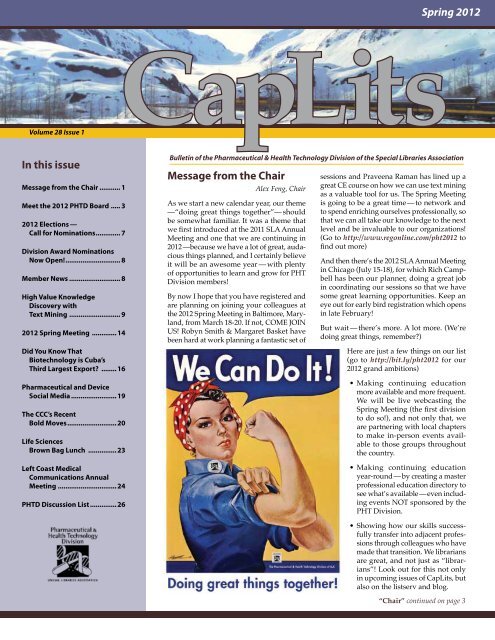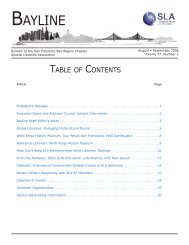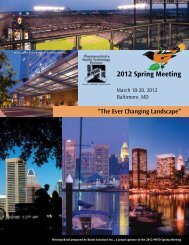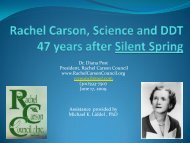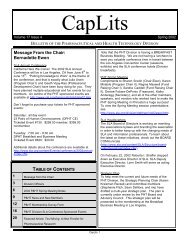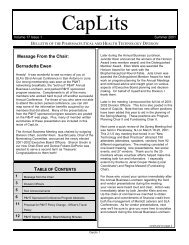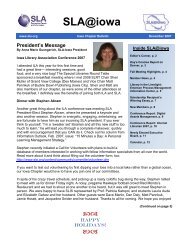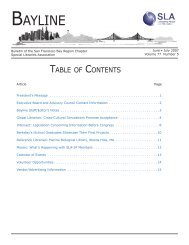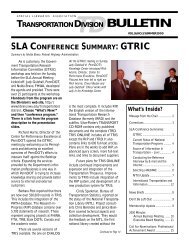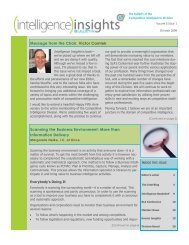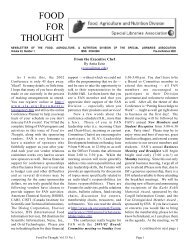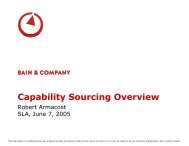Message from the Chair In this issue Spring 2012 - units.sla.org ...
Message from the Chair In this issue Spring 2012 - units.sla.org ...
Message from the Chair In this issue Spring 2012 - units.sla.org ...
Create successful ePaper yourself
Turn your PDF publications into a flip-book with our unique Google optimized e-Paper software.
Volume 28 Issue 1<br />
<strong>In</strong> <strong>this</strong> <strong>issue</strong><br />
<strong>Message</strong> <strong>from</strong> <strong>the</strong> <strong>Chair</strong> ........... 1<br />
Meet <strong>the</strong> <strong>2012</strong> PHTD Board ..... 3<br />
<strong>2012</strong> Elections —<br />
Call for Nominations ............. 7<br />
Division Award Nominations<br />
Now Open! ............................. 8<br />
Member News ........................... 8<br />
High Value Knowledge<br />
Discovery with<br />
Text Mining ........................... 9<br />
<strong>2012</strong> <strong>Spring</strong> Meeting ............. 14<br />
Did You Know That<br />
Biotechnology is Cuba’s<br />
Third Largest Export? ........ 16<br />
Pharmaceutical and Device<br />
Social Media ........................ 19<br />
The CCC’s Recent<br />
Bold Moves .......................... 20<br />
Life Sciences<br />
Brown Bag Lunch ............... 23<br />
Left Coast Medical<br />
Communications Annual<br />
Meeting ............................... 24<br />
PHTD Discussion List .............. 26<br />
CapLits<br />
Bulletin of <strong>the</strong> Pharmaceutical & Health Technology Division of <strong>the</strong> Special Libraries Association<br />
<strong>Message</strong> <strong>from</strong> <strong>the</strong> <strong>Chair</strong><br />
Alex Feng, <strong>Chair</strong><br />
As we start a new calendar year, our <strong>the</strong>me<br />
—“doing great things toge<strong>the</strong>r”— should<br />
be somewhat familiar. It was a <strong>the</strong>me that<br />
we first introduced at <strong>the</strong> 2011 SLA Annual<br />
Meeting and one that we are continuing in<br />
<strong>2012</strong> —because we have a lot of great, audacious<br />
things planned, and I certainly believe<br />
it will be an awesome year — with plenty<br />
of opportunities to learn and grow for PHT<br />
Division members!<br />
By now I hope that you have registered and<br />
are planning on joining your colleagues at<br />
<strong>the</strong> <strong>2012</strong> <strong>Spring</strong> Meeting in Baltimore, Maryland,<br />
<strong>from</strong> March 18-20. If not, COME JOIN<br />
US! Robyn Smith & Margaret Basket have<br />
been hard at work planning a fantastic set of<br />
<strong>Spring</strong> <strong>2012</strong><br />
sessions and Praveena Raman has lined up a<br />
great CE course on how we can use text mining<br />
as a valuable tool for us. The <strong>Spring</strong> Meeting<br />
is going to be a great time — to network and<br />
to spend enriching ourselves professionally, so<br />
that we can all take our knowledge to <strong>the</strong> next<br />
level and be invaluable to our <strong>org</strong>anizations!<br />
(Go to http://www.regonline.com/pht<strong>2012</strong> to<br />
find out more)<br />
And <strong>the</strong>n <strong>the</strong>re’s <strong>the</strong> <strong>2012</strong> SLA Annual Meeting<br />
in Chicago (July 15-18), for which Rich Campbell<br />
has been our planner, doing a great job<br />
in coordinating our sessions so that we have<br />
some great learning opportunities. Keep an<br />
eye out for early bird registration which opens<br />
in late February!<br />
But wait — <strong>the</strong>re’s more. A lot more. (We’re<br />
doing great things, remember?)<br />
Here are just a few things on our list<br />
(go to http://bit.ly/pht<strong>2012</strong> for our<br />
<strong>2012</strong> grand ambitions)<br />
• Making continuing education<br />
more available and more frequent.<br />
We will be live webcasting <strong>the</strong><br />
<strong>Spring</strong> Meeting (<strong>the</strong> first division<br />
to do so!), and not only that, we<br />
are partnering with local chapters<br />
to make in-person events available<br />
to those groups throughout<br />
<strong>the</strong> country.<br />
• Making continuing education<br />
year-round — by creating a master<br />
professional education directory to<br />
see what’s available — even including<br />
events NOT sponsored by <strong>the</strong><br />
PHT Division.<br />
• Showing how our skills successfully<br />
transfer into adjacent professions<br />
through colleagues who have<br />
made that transition. We librarians<br />
are great, and not just as “librarians”!<br />
Look out for <strong>this</strong> not only<br />
in upcoming <strong>issue</strong>s of CapLits, but<br />
also on <strong>the</strong> listserv and blog.<br />
“<strong>Chair</strong>” continued on page 3
CapLits – <strong>Spring</strong> <strong>2012</strong><br />
2
“<strong>Chair</strong>” continued <strong>from</strong> page 1<br />
• Moving our website to <strong>the</strong> Wordpress platform. This should<br />
be done by <strong>Spring</strong> Meeting and should allow for more<br />
updated content with no downtime — and more ways to<br />
learn and connect for you!<br />
And <strong>this</strong> is not including all of <strong>the</strong> resources that already exist,<br />
such as <strong>the</strong> listserv and Linked<strong>In</strong> group. Make sure to plug in,<br />
as <strong>the</strong>se are primary vehicles for not only peer growth, but<br />
also job opportunities and for your leadership to communicate<br />
division news! (See ‘Key PHT Division Resources’ on page 12.)<br />
Excited yet? I am! This is shaping up to be an exhilarating year<br />
with many things to shoot for — join in, participate, and let’s<br />
do great things toge<strong>the</strong>r!<br />
Meet <strong>the</strong> <strong>2012</strong> PHTD Board<br />
Alex Feng, <strong>Chair</strong><br />
Alexander Feng is <strong>the</strong> Director of Strategic<br />
Research at <strong>the</strong> dd+p group, a medical<br />
device, diagnostics, and pharmaceutical<br />
consultancy. His previous experience<br />
includes roles in <strong>In</strong>formation Management,<br />
<strong>In</strong>formation Technology, Sales,<br />
Research & Development, and Business<br />
Development at Daiichi Sankyo, Ethicon<br />
Endo-Surgery, a Johnson & Johnson company,<br />
SirsiDynix and Hologic. He lives in Cincinnati, Ohio with<br />
his fantastic wife Laura and <strong>the</strong>ir three little ones Hannah,<br />
Timothy, and Phoebe.<br />
“Meet <strong>the</strong> Board” continued on page 5<br />
Volume 28, Issue 1 <strong>Spring</strong> <strong>2012</strong><br />
CapLits is published three times a year by <strong>the</strong> Pharmaceutical<br />
& Health Technology Division (PHTD) of <strong>the</strong> Special<br />
Libraries Association and is sent to Division members as<br />
a benefit of membership. Special Libraries Association<br />
assumes no responsibility for any of <strong>the</strong> statements and<br />
opinions advanced by <strong>the</strong> contribution to <strong>the</strong> Association’s<br />
publications. Editorial views do not necessarily represent<br />
<strong>the</strong> official position of <strong>the</strong> Special Libraries Association.<br />
Acceptance of advertisements does not imply endorsement<br />
of <strong>the</strong> product by Special Libraries Association.<br />
Editor: Praveena Raman<br />
Production Editor: Mark Domke<br />
Production Designer: Jay Fraser<br />
Advertising Editor: Janet Weiss<br />
Advertising Rates (<strong>2012</strong>)<br />
Full Page: $550 per <strong>issue</strong><br />
Half Page: $300 per <strong>issue</strong><br />
Quarter Page: $150 per <strong>issue</strong><br />
<strong>In</strong>side Front or Back Cover: $600 per <strong>issue</strong><br />
Outside Back Cover: $650 per <strong>issue</strong><br />
If you are interested in advertising in CapLits, more information<br />
can be found at:<br />
http://<strong>units</strong>.<strong>sla</strong>.<strong>org</strong>/division/dpht/CapLits/caplits.shtml<br />
<strong>2012</strong> Executive Board<br />
<strong>Chair</strong>: Alexander Feng<br />
ahf25du@gmail.com<br />
<strong>Chair</strong> Elect: Mary Chitty<br />
mchitty@healthtech.com<br />
Past <strong>Chair</strong>: Margaret Basket<br />
margaretb@quosa.com<br />
Treasurer: Rick Raske<br />
treasurer@pht.<strong>sla</strong>.<strong>org</strong><br />
Secretary: Sidney McNab<br />
s.mcnab@lek.com<br />
Division Committees<br />
& Advisory Council<br />
CapLits – <strong>Spring</strong> <strong>2012</strong><br />
Pharmaceutical &<br />
Health Technology<br />
Division <strong>2012</strong> Officers<br />
Awards <strong>Chair</strong>: Margaret Basket<br />
margaretb@quosa.com<br />
Business Manager for Bulletin & Publications:<br />
Janet Weiss<br />
jweiss@dsi.com<br />
CapLits Editor: Praveena Raman<br />
praveena.raman@gmail.com<br />
CapLits Production Editor: Mark Domke<br />
mdomke@prescottmed.com<br />
Career Guidance/Student Relations <strong>Chair</strong>:<br />
Rochelle Stern<br />
rcls@novonordisk.com<br />
Division Archivist: Paul Ziegler<br />
paul_ziegler@merck.com<br />
Division List Owner: Julia Parker<br />
bioslueth@gmail.com<br />
Employment <strong>Chair</strong>: Natalie Rainford<br />
natalie.rainford@us.astellas.com<br />
Fundraising <strong>Chair</strong>: Sandra Baker<br />
sandra.baker@cancom.com<br />
3
CapLits – <strong>Spring</strong> <strong>2012</strong><br />
4
“Meet <strong>the</strong> Board” continued <strong>from</strong> page 3<br />
Mary Chitty, <strong>Chair</strong> Elect<br />
Mary Chitty is Library Director & Taxonomist<br />
at Cambridge Healthtech in Needham<br />
MA. She wrote <strong>the</strong> chapter on<br />
Genomics, Proteomics and Bioinformatics<br />
for Using <strong>the</strong> Pharmaceutical Literature,<br />
Taylor & Francis, 2006. She is <strong>the</strong> author of<br />
Federal <strong>In</strong>formation Sources in Health and<br />
Medicine (Greenwood Press, 1988) and<br />
reviews biotech and medical books for<br />
Library Journal. She was also on <strong>the</strong> executive board of SLA’s<br />
Taxonomy Division. She was previously Head of Reference at<br />
<strong>the</strong> Library of <strong>the</strong> Massachusetts College of Pharmacy, Boston<br />
MA, and supervised <strong>the</strong> Air Pollution Technical <strong>In</strong>formation<br />
Center at <strong>the</strong> US EPA Library, Research Triangle Park, NC.<br />
Starting out as a picture researcher and fact- checker in <strong>the</strong> US<br />
and England, she has an MSLS <strong>from</strong> <strong>the</strong> University of North<br />
Carolina – Chapel Hill and a BA in Anthropology <strong>from</strong> Yale,<br />
as one of <strong>the</strong> first class of undergraduate women. Her interests<br />
include pre-competitive collaboration, fostering communication<br />
among biologists, chemists, clinicians, IT, business and<br />
legal people, late 19th century American <strong>the</strong>ater, and medical<br />
and pharmaceutical history.<br />
Sidney McNab, Secretary<br />
Sidney McNab has been with L.E.K. Consulting<br />
as long as she has been in <strong>the</strong> information<br />
profession, starting part-time in<br />
1998 while still a student in Simmons College’s<br />
GSLIS Master’s program. L.E.K.<br />
Consulting is a 600+ global management<br />
consulting firm that assists companies in a<br />
wide range of industries, including a substantial<br />
Life Sciences practice. Currently<br />
Sidney is <strong>the</strong> Director of U.S. <strong>In</strong>formation Centers, overseeing<br />
three physical centers and a staff of four. An SLA member since<br />
1999, Sidney has been active in <strong>the</strong> B&F and PHT Divisions as<br />
well as <strong>the</strong> local Boston Chapter.<br />
Richard Raske, Treasurer<br />
Rick Raske’s professional career in information<br />
started in <strong>the</strong> late 1970s at Baxter<br />
Healthcare (Travenol Laboratories at <strong>the</strong><br />
time). Previously, his “formative years”<br />
were spent working in <strong>the</strong> periodical<br />
bank of <strong>the</strong> former North Suburban<br />
Library System during college. <strong>In</strong> <strong>the</strong><br />
1990s he worked for Clintec Nutrition and<br />
<strong>the</strong>n Nestle Clinical Nutrition. Rick has<br />
expertise in competitive intelligence, market research, pharmacovigilance,<br />
and drug & device pipelines. He manages collaboration,<br />
knowledge management, pharmacovigilance, and<br />
o<strong>the</strong>r programs and projects, and also curates an internal<br />
innovation blog.<br />
<strong>In</strong> addition to participation in <strong>the</strong> Special Libraries Association,<br />
he volunteers in his community at a central-city health clinic<br />
and at cultural, 4-H, and Wisconsin Horse Council events.<br />
Membership <strong>Chair</strong>: Bonnie Snow<br />
snow.bonnie@yahoo.com<br />
Networking <strong>Chair</strong>: Bonnie Snow<br />
snow.bonnie@yahoo.com<br />
CapLits – <strong>Spring</strong> <strong>2012</strong><br />
Nominating Committee <strong>Chair</strong>: Christine Geluk<br />
Christine_Geluk@eisai.com<br />
Professional Development <strong>Chair</strong>:<br />
Magan Stephens<br />
Magan.Stephens@gilead.com<br />
Program Planning <strong>Chair</strong> I: Richard Campbell<br />
rcam@novonordisk.com<br />
Program Planning <strong>Chair</strong> II: Jeanie Fraser<br />
cacurlytop@mac.com<br />
Program Planning <strong>Chair</strong> III: Robyn Smith<br />
robyn.smith@takeda.com<br />
Public Relations <strong>Chair</strong>: Sean Smith<br />
seans@quosa.com<br />
Section <strong>Chair</strong>: Peggy Burnett<br />
peggy.burnett@novartis.com<br />
Strategic Planning <strong>Chair</strong>: Margaret Basket<br />
margaretb@quosa.com<br />
Webmaster: Paul Ziegler<br />
paul_ziegler@merck.com<br />
5
CapLits – <strong>Spring</strong> <strong>2012</strong><br />
6
<strong>2012</strong> Elections — Call for Nominations for <strong>Chair</strong>-Elect & Secretary<br />
The Pharmaceutical and Health Technology Division is identifying<br />
candidates for <strong>Chair</strong>-Elect and Secretary for <strong>the</strong> <strong>2012</strong> election.<br />
Becoming a PHTD officer doesn’t mean you’ll be working<br />
alone. You have <strong>the</strong> help of <strong>the</strong> current and past division officers,<br />
and a host of hard working division members. You may<br />
also be eligible for financial support <strong>from</strong> <strong>the</strong> Division to attend<br />
meetings like <strong>the</strong> Leadership Summit and Annual meetings.<br />
Your participation in divisional governance and <strong>the</strong> election<br />
process is vital to <strong>the</strong> continued success of <strong>the</strong> Pharmaceutical<br />
and Health Technology Division.<br />
The duties for each position are explained below (excerpted<br />
<strong>from</strong> <strong>the</strong> Division Policies and Procedures Manual):<br />
<strong>Chair</strong>-Elect<br />
<strong>In</strong> 2013, <strong>the</strong> <strong>Chair</strong>-Elect is responsible for learning as much as<br />
possible about <strong>the</strong> operation of <strong>the</strong> Division, so that when he/<br />
she assumes <strong>the</strong> <strong>Chair</strong> <strong>the</strong> following year (2014), <strong>the</strong> transition<br />
will be smooth and <strong>the</strong> Division will continue to operate<br />
efficiently and in accordance with <strong>the</strong> Division Governing<br />
Guidelines and <strong>the</strong> procedures outlined in <strong>the</strong> Division Policies<br />
& Procedures manual.<br />
Duties:<br />
Serves on <strong>the</strong> Division Executive Board. With <strong>the</strong> <strong>Chair</strong>, represents<br />
<strong>the</strong> Division at Division Cabinet meetings at <strong>the</strong> Annual<br />
Association meeting and <strong>the</strong> Leadership Summit. Assists <strong>the</strong><br />
<strong>Chair</strong> as required in <strong>the</strong> performance of his/her duties. Shall<br />
be responsible for planning and execution of <strong>the</strong> Division’s<br />
Programming at <strong>the</strong> Annual Meeting held in <strong>the</strong> year as <strong>Chair</strong><br />
and for <strong>the</strong> appointment of any Committees or liaisons in relation<br />
to <strong>this</strong> meeting. <strong>In</strong> <strong>the</strong> event of <strong>the</strong> absence or resignation of<br />
<strong>the</strong> <strong>Chair</strong>, shall assume <strong>the</strong> duties of <strong>the</strong> <strong>Chair</strong>. Makes plans for<br />
SLA CAREER CENTER<br />
Post Resumes<br />
Search for Jobs<br />
Career Advice<br />
Find <strong>the</strong> right job in your industry.<br />
Useful Resources<br />
Seminars<br />
CapLits – <strong>Spring</strong> <strong>2012</strong><br />
<strong>the</strong> following year, including preparing a tentative outline of<br />
<strong>the</strong> program plans and meeting locations, lining up Committee<br />
<strong>Chair</strong>s and editors, identifying special projects to be presented<br />
to <strong>the</strong> Board, and developing his/her approach to supervising<br />
<strong>the</strong> activities of <strong>the</strong> <strong>org</strong>anization.<br />
Attends <strong>the</strong> planning meetings for <strong>the</strong> Annual Meeting, held<br />
at <strong>the</strong> Leadership Summit, during <strong>the</strong>ir year as <strong>Chair</strong>-Elect in<br />
preparation for planning <strong>the</strong> Annual Meeting to occur approximately<br />
eighteen months later. Undertakes special assignments<br />
as requested by <strong>the</strong> <strong>Chair</strong>. Assumes <strong>the</strong> position of <strong>Chair</strong> in<br />
2014 and Past <strong>Chair</strong> in 2015.<br />
Secretary<br />
The Secretary is elected for a two-year term (2013-2014) and is<br />
responsible for most of <strong>the</strong> recording and circulating tasks in<br />
<strong>the</strong> Division. The position requires a person with good writing<br />
skills who is willing to commit to attending all Division<br />
meetings.<br />
Duties:<br />
Serves on <strong>the</strong> Executive Board. Takes attendance at Executive<br />
Board/Advisory Council meetings, listing those present in<br />
minutes. Records minutes of all meetings of <strong>the</strong> Division and<br />
<strong>the</strong> Executive Board/Advisory Council and distributes all<br />
minutes to Division Board, Division Archivist and to all Division<br />
members via <strong>the</strong> Division Website/Wiki, Division Bulletin<br />
(optional), and Division Blog (optional).<br />
If you are interested in learning more about ei<strong>the</strong>r of <strong>the</strong>se<br />
positions, or if you would like to become or recommend a candidate,<br />
please contact <strong>the</strong> Nominating <strong>Chair</strong>, Christine Geluk<br />
at Christine_Geluk@eisai.com.<br />
www.<strong>sla</strong>.<strong>org</strong>/careers<br />
7
CapLits – <strong>Spring</strong> <strong>2012</strong><br />
8<br />
Division Award Nominations Now Open!<br />
One of <strong>the</strong> highlights of <strong>the</strong> Division business meeting in Chicago<br />
will be <strong>the</strong> announcement of <strong>the</strong> winners of <strong>the</strong> Division’s<br />
Horizon and Distinguished Member Awards. You can<br />
participate in <strong>this</strong> process by nominating worthy individuals<br />
to win <strong>the</strong>se awards.<br />
The Horizon Award (also known as <strong>the</strong> new member award)<br />
honors a PHT Division member who has been a member for<br />
five (5) or fewer years who has shown <strong>the</strong> promise of becoming<br />
an outstanding member of <strong>the</strong> profession. This award represents<br />
an evaluation of an individual’s work and participation in<br />
professional and Division activities. Particular consideration is<br />
given to contributions to <strong>the</strong> PHT Division. The winner of <strong>the</strong><br />
Horizon Award receives a certificate and $500. Here is a list of<br />
<strong>the</strong> recipients of <strong>the</strong> Horizon Award for <strong>the</strong> previous five years:<br />
2011 Sandra Baker 2008 Alexander Feng<br />
2010 Patrice Costa 2007 Jillian Amaral<br />
2009 Hea<strong>the</strong>r Blaine 2006 Paul Ziegler<br />
The Distinguished Member Award honors a PHT Division<br />
member for notable and enduring contributions and service<br />
to <strong>the</strong> Division and <strong>the</strong> profession. The award represents a<br />
cumulative evaluation of an individual’s career and emphasizes<br />
sustained division leadership and activity of an exem-<br />
Member News:<br />
SLA-PHTD Member Elected SLA President-Elect<br />
Deb Hunt stepped into <strong>the</strong> SLA President-Elect office on<br />
January 1, <strong>2012</strong> and looks forward to meeting more members<br />
and leading SLA during challenging times, both economically<br />
and for our profession. Deb is an independent<br />
information<br />
outlook<br />
ALWAYS ON YOUR DESKTOP.<br />
plary nature. The winner of Distinguished Member Award<br />
receives a certificate and $750. Here is a list of <strong>the</strong> recipients of<br />
<strong>the</strong> Distinguished Member Award for <strong>the</strong> previous five years:<br />
2011 Janet Weiss<br />
2010 Bob Kowalski, Robyn Smith, Praveena Raman<br />
2009 Susan Gleckner, Wendy Hamilton<br />
2008 Peggy Burnett, Claudia Cuca<br />
2007 Karen Mirabile<br />
2006 John Carey, Stephanie Fitch, Bonnie Snow, Larry<br />
Walton<br />
Any member of <strong>the</strong> PHT Division can nominate a person for<br />
an award. Self nominations will be accepted. Current Executive<br />
Board members and Award Committee members are ineligible<br />
for nomination. Nominations do not carry over <strong>from</strong> one year<br />
to <strong>the</strong> next. This is a confidential process, so do not inform <strong>the</strong><br />
nominee or your Division colleagues of <strong>the</strong> name you have submitted.<br />
After <strong>the</strong> Committee’s deliberations, all documents are<br />
destroyed except those needed for preparing publicity releases.<br />
Go to http://bit.ly/pht_awards and click on <strong>the</strong> Awards link to<br />
find <strong>the</strong> nomination forms (look under <strong>the</strong> description of each<br />
award). Nominations are due to Margaret Basket (dpht@mac.<br />
com) on or before June 11, <strong>2012</strong>.<br />
information professional and Principal of <strong>In</strong>formation Edge,<br />
which specializes in value-added research, knowledge services,<br />
enterprise content management, and library creation<br />
and automation. She is an active member in <strong>the</strong> Association<br />
of <strong>In</strong>dependent <strong>In</strong>formation Professionals (AIIP) and served<br />
on its Board of Directors <strong>from</strong> 2001-2003.<br />
www.<strong>sla</strong>.<strong>org</strong>/io
High Value Knowledge Discovery with Text Mining —<br />
Realizing <strong>the</strong> Full Potential of Your <strong>In</strong>formation Resources<br />
Business and research <strong>org</strong>anizations face a huge challenge in<br />
<strong>the</strong> form of overwhelming quantities of information contained<br />
within internal documents and external literature. The challenge<br />
is to unlock <strong>the</strong> meaning within <strong>this</strong> text so that it can be<br />
used for decision making. By extracting structured information<br />
<strong>from</strong> unstructured text, we can answer questions, find trends,<br />
and discover hidden knowledge, combining evidence <strong>from</strong><br />
multiple documents and document silos. We can also use <strong>the</strong><br />
relationships extracted <strong>from</strong> <strong>the</strong> text to enhance and to connect<br />
existing databases.<br />
Addressing <strong>this</strong> challenge requires advanced informationextraction<br />
methods<br />
that go beyond<br />
both information<br />
retrieval<br />
(IR) approaches<br />
familiar to search<br />
engine users<br />
and traditional<br />
information<br />
extraction (IE)<br />
approaches that<br />
are programmed<br />
for a limited set<br />
of questions. <strong>In</strong><br />
particular it is Figure 1: The <strong>In</strong>formation Extraction Process<br />
key for users to<br />
have <strong>the</strong> ability<br />
to ask arbitrary<br />
questions and to<br />
get back results quickly, similar to using a search engine, combined<br />
with <strong>the</strong> ability to provide very precise results including<br />
facts and relationships in a standardized, structured format<br />
ready for fur<strong>the</strong>r analysis and integration.<br />
The Business Case for Text Mining<br />
There is a huge amount of information available to <strong>org</strong>anizations<br />
in <strong>the</strong> form of unstructured text. This can comprise<br />
internal documents, such as research reports, electronic patient<br />
records, meeting minutes, and also external literature collections.<br />
For example, <strong>the</strong> MEDLINE database of scientific<br />
papers relevant to <strong>the</strong> life sciences contains over twenty million<br />
abstracts, and continues to add citations at <strong>the</strong> rate of over<br />
one thousand per day.<br />
Fur<strong>the</strong>rmore, taking <strong>the</strong> pharmaceutical industry as an<br />
example:<br />
• around 90% of drug targets are derived <strong>from</strong> <strong>the</strong> literature<br />
and most research for drug discovery is produced external<br />
to any individual company. This makes mining of external<br />
literature crucial for discovery companies;<br />
• surveys have suggested that half of all potentially <strong>the</strong>rapeutic<br />
compounds fail due to safety concerns, and around<br />
CapLits – <strong>Spring</strong> <strong>2012</strong><br />
half of <strong>the</strong>se had some indication of toxicity in <strong>the</strong> literature<br />
that was not noticed until after experimental evidence arose;<br />
• 80% of information generally available to an <strong>org</strong>anization<br />
is in <strong>the</strong> form of unstructured text, ra<strong>the</strong>r than data that is<br />
tabular or stored in a database and <strong>this</strong> information is rarely<br />
exploited to its full potential.<br />
The life sciences domain provides just one example area<br />
where <strong>the</strong>re is an ongoing requirement for high performance<br />
text mining. Within <strong>the</strong> business intelligence arena, business<br />
and media analysts also now have almost unlimited riches in<br />
<strong>the</strong>ir source material,<br />
with live<br />
news feeds and<br />
on-line reports.<br />
But <strong>this</strong> wealth<br />
can be as much<br />
of a headache<br />
as a help when<br />
<strong>the</strong> need is to<br />
answer specific<br />
questions quickly<br />
and accurately<br />
— such as “what<br />
licensing opportunities<br />
are <strong>the</strong>re<br />
for a particular<br />
technology?”<br />
or “what companies<br />
are our<br />
competitors doing<br />
business with?” The volume of available data can actually<br />
act as a barrier to knowledge and effectiveness.<br />
IDC has estimated that an enterprise employing one thousand<br />
knowledge workers wastes nearly $2.5m per year simply due<br />
to an inability to locate and retrieve information, resulting in<br />
lost opportunities and diminished competitiveness.<br />
Towards <strong>In</strong>teractive <strong>In</strong>formation Extraction<br />
IR systems, such as Google, appeal because <strong>the</strong>y are easy to<br />
use and, for tasks such as finding a review of <strong>the</strong> latest laptops,<br />
<strong>the</strong>y perform very well. However, when <strong>the</strong> task is not to<br />
locate a third-party resource (such as a web site or document),<br />
but to answer a question, to find a relationship between two<br />
entities, or to understand gene-disease relationships, <strong>the</strong>y fall<br />
short. Even if <strong>the</strong> correct documents are found, <strong>the</strong> user <strong>the</strong>n<br />
has to find <strong>the</strong> information within <strong>the</strong> document, and deduce a<br />
comprehensive answer. This can be a very long and sometimes<br />
error-prone process.<br />
Advanced information extraction (IE) provides a solution. It<br />
uses natural language processing (NLP) to extract relationships<br />
and facts ra<strong>the</strong>r than simply returning lists of documents. It<br />
provides <strong>the</strong>se results in a convenient, structured form for easy<br />
review and fur<strong>the</strong>r analysis, for example in a spreadsheet or<br />
“Text Mining” continued on page 10<br />
9
CapLits – <strong>Spring</strong> <strong>2012</strong><br />
“Text Mining” continued <strong>from</strong> page 9<br />
a database. It performs a linguistic analysis of documents so<br />
that searches can be both more flexible and more precise than<br />
simply using keywords, and hence more powerful.<br />
The challenge is to develop methods that blend <strong>the</strong> best of <strong>the</strong><br />
IR and IE approaches. The rest of <strong>this</strong> article explores <strong>this</strong> challenge<br />
and <strong>the</strong> way it has been met via interactive text mining<br />
technology.<br />
<strong>In</strong>put and Output<br />
We have already said that <strong>the</strong>re is a limitation with IR, but in<br />
fact <strong>the</strong> problem is twofold: <strong>the</strong> query input and <strong>the</strong> results<br />
output. <strong>In</strong>put to an IR system is typically a “bag of words” to<br />
be matched against all of <strong>the</strong> documents that <strong>the</strong> system knows<br />
about. The output is a list of <strong>the</strong> documents which best match<br />
<strong>the</strong> input words (according to some relevance ranking).<br />
The input can be a problem when, for example, <strong>the</strong> user wants<br />
to search for types, or classes, of things ra<strong>the</strong>r than instances<br />
(e.g. for “any search company” ra<strong>the</strong>r than for “Google”) or<br />
when one particular meaning of a word with multiple meanings<br />
is intended (e.g. “associate” as a noun ra<strong>the</strong>r than a verb).<br />
The output is a problem when <strong>the</strong> user wants structured results<br />
ra<strong>the</strong>r than a list of documents on some subject. For instance,<br />
discovering which proteins interact with which o<strong>the</strong>r proteins<br />
(information which is very useful in <strong>the</strong> life sciences) would be<br />
very time-consuming using an IR engine. Not only would <strong>the</strong><br />
user need to come up with a list of proteins and all <strong>the</strong> different<br />
ways <strong>the</strong>y can be expressed in <strong>the</strong> literature (<strong>the</strong>ir synonyms),<br />
<strong>the</strong>y would <strong>the</strong>n have to read all of <strong>the</strong> documents returned<br />
by <strong>the</strong> IR engine and pick out <strong>the</strong> interactions by hand. And<br />
<strong>the</strong>re is no guarantee that a document which mentions a protein<br />
describes its interactions with ano<strong>the</strong>r protein.<br />
Some systems try to boost performance by providing semantic<br />
expansion of keywords. For example, consider if you are<br />
interested in finding “companies operating in <strong>the</strong> United Kingdom.”<br />
Expansion of “company” may provide <strong>the</strong> keyword<br />
“corporation” as well as “<strong>org</strong>anization”. However, it will not<br />
find documents that only mention a particular company, such<br />
as “IBM”. There are only a small number of synonyms for<br />
most individual words, but <strong>the</strong>re can be many thousands of<br />
members of a class.<br />
O<strong>the</strong>r systems add categorization or classification (where<br />
results are clustered for easier browsing) but <strong>the</strong> underlying<br />
approach of inputting words and returning documents<br />
remains.<br />
<strong>In</strong>formation Extraction<br />
<strong>In</strong>formation extraction methods solve <strong>the</strong>se problems, allowing<br />
users to create more sophisticated queries and applying NLP<br />
methods to extract more specific and relevant information into<br />
a format ready for fur<strong>the</strong>r processing or presentation.<br />
See Figure 1: The <strong>In</strong>formation Extraction Process<br />
Typical IE systems are not designed for interactive use. Query<br />
patterns are developed by experts in both NLP and <strong>the</strong> domain.<br />
These are <strong>the</strong>n run over <strong>the</strong> data, sentence by sentence. This<br />
10<br />
lack of interactivity means that typical IE systems are only<br />
appropriate for predictable queries. Development of queries is<br />
also much slower which can affect <strong>the</strong> quality that is achieved,<br />
<strong>In</strong>teractive information extraction combines NLP technology<br />
and search technology to give a very different experience,<br />
where users can iteratively develop <strong>the</strong>ir own high quality<br />
queries over large-scale data sources including millions of<br />
documents.<br />
<strong>In</strong>corporating Domain Knowledge<br />
Natural language processing can incorporate knowledge<br />
sources, such as employee lists, lists of product names, or terminologies<br />
which capture <strong>the</strong> “language” of a domain. Traditional<br />
information extraction systems allow just a few concepts or<br />
classes, e.g. people, companies, genes and diseases. <strong>In</strong> contrast,<br />
interactive information extraction can deal with hundreds of<br />
thousands of different classes, arranged in complex hierarchies<br />
or directed graphs. Users can include <strong>the</strong>ir own terminologies<br />
or large scale public external resources such as <strong>the</strong> SNOMED<br />
clinical terminology, MedDRA medical dictionary, or <strong>the</strong> Entrez<br />
Gene database.<br />
<strong>In</strong>tegrating domain knowledge into <strong>the</strong> system creates a very<br />
powerful search tool.4 Simple expressions of domain knowledge<br />
– such as staff or project lists – can be turned into classes<br />
(concepts or entities), to provide more targeted search.<br />
The language used in a domain such as life sciences is usually<br />
more than mere terminology, as captured in a dictionary. It also<br />
expresses <strong>the</strong> categorization of, and relationships between, <strong>the</strong><br />
concepts it describes. For example, in life sciences we need to<br />
know not simply what “MEK” or “protein kinase” means, but<br />
also that MEK is a protein kinase. We also need to know, for<br />
example, that “phosphorylation” is a type of direct relationship<br />
that can occur between two proteins. This description of entities,<br />
concepts, <strong>the</strong>ir synonyms and relationships is an ontology.<br />
Making a system open to importing ontologies means that its<br />
power can be quickly and easily deployed in any domain, with<br />
no need to “reprogram” <strong>the</strong> core system.<br />
Case Study: The Pharmaceutical Sector<br />
We have discussed some of <strong>the</strong> <strong>issue</strong>s surrounding text mining,<br />
investigated <strong>the</strong> need for interactive information extraction,<br />
and reviewed some of <strong>the</strong> technical <strong>issue</strong>s involved in delivering<br />
it. Let’s close by looking at a real example of its use.<br />
We began with <strong>the</strong> example of <strong>the</strong> life sciences industry,<br />
where spotting blind alleys and finding productive avenues<br />
for research as early as possible are critical for reducing <strong>the</strong><br />
multimillion dollar cost of developing a drug. We saw how<br />
<strong>the</strong> volume of research data is growing exponentially. Some<br />
tools that are commonly available for keeping up with <strong>this</strong><br />
data within <strong>this</strong> industry are:<br />
• Keyword search tools for finding relevant documents or<br />
abstracts,<br />
• (hand) curated databases, for example, those of proteinprotein<br />
interactions,<br />
“Text Mining” continued on page 12
CapLits – <strong>Spring</strong> <strong>2012</strong><br />
11
CapLits – <strong>Spring</strong> <strong>2012</strong><br />
“Text Mining” continued <strong>from</strong> page 10<br />
• Tools for searching/mining/sequencing database information.<br />
The discussion above has described <strong>the</strong> limitations of such<br />
approaches when most of <strong>the</strong> available information is in <strong>the</strong><br />
form of unstructured text. <strong>In</strong>teractive information extraction<br />
has saved weeks to months spent on unnecessary experiments<br />
and unproductive literature reviews by rapidly extracting <strong>the</strong><br />
information required.<br />
<strong>In</strong>teractive information extraction has been used in <strong>the</strong> pharmaceutical<br />
industry for over 8 years in a wide variety of applications.<br />
One example of its use at AstraZeneca was to mine <strong>the</strong><br />
MEDLINE database and EMBASE data sources for nuclear<br />
receptor cofactors – typical of <strong>the</strong> information sought in drug<br />
discovery projects. Before using NLP, <strong>the</strong> process involved<br />
finding <strong>the</strong> most relevant looking abstracts using standard<br />
search, followed by reading of <strong>the</strong> abstracts. Approximately<br />
one hundred abstracts could be manually analyzed for cofactors<br />
in one person-day. By using NLP around 8,000 abstracts<br />
were analyzed, and cofactors were extracted and checked, in<br />
2 hours. The results closely paralleled <strong>the</strong> results <strong>from</strong> hand<br />
analysis, and showed a 10-fold reduction in overall personhours.<br />
Moreover, <strong>the</strong> system also discovered new cofactors<br />
not in <strong>the</strong> standard set.<br />
Summary<br />
The interactive information extraction approach enables users<br />
across <strong>the</strong> enterprise to find sophisticated relationships within<br />
unstructured text, and allows <strong>the</strong> production of relevant, usable<br />
results in a structured format. It can do <strong>this</strong> with unparalleled<br />
speed allowing ad-hoc or validated queries over millions of<br />
documents. Having a graphical interface provides for ease of<br />
use, opening up advanced natural language-based search to<br />
non-linguists and non-programmers.<br />
With appropriate knowledge sources, <strong>the</strong> technology can be<br />
deployed in almost any area. For example, with knowledge<br />
about companies, it can be used as a business intelligence tool;<br />
with knowledge about people and your internal projects it can<br />
be used to build a database of who worked on which projects –<br />
and be kept up to date by running over your internal reports.<br />
References:<br />
1. Roberts, P. M. (2006) Mining Literature for Systems Biology,<br />
Briefings in Bioinformatics, 7(4), 399-406.<br />
2. Fickett, J. and Hayes, W. (2004) Text Mining for Drug Discovery,<br />
European Pharmaceutical Contractor, Autumn 2004.<br />
3. Feldman, S. and Sherman, C. (2001) The High Cost of Not<br />
Finding <strong>In</strong>formation, IDC White Paper.<br />
4. Milward, D., Bjäreland, M., Hayes, W., Maxwell, M., Öberg,<br />
L., Tilford, N., Thomas, J., Hale, R., Knight, S., and Barnes,<br />
J. (2005) Ontology-based <strong>In</strong>teractive <strong>In</strong>formation Extraction<br />
<strong>from</strong> Scientific Abstracts, Comparative and Functional<br />
Genomics, 6, 67-71.<br />
5. Milward, D., Blaschke, C., Neefs, J.-M., Ott, M.-C., Verbeeck,<br />
R., and Stubbs, A. (2006) Flexible Text Mining Strategies for<br />
12<br />
Drug Discovery, Proc. Second <strong>In</strong>ternational Symposium on<br />
Semantic Mining in BioMedicine (SMBM 2006), 101-104.<br />
6. Shannon, P., Markiel, A., Ozier, O., Baliga, N.S., Wang, J.T.,<br />
Ramage, D., Amin, N., Schwikowski, B., and Ideker, T. (2003)<br />
Cytoscape: A Software Environment for <strong>In</strong>tegrated Models of<br />
Biomolecular <strong>In</strong>teraction Networks, Genome Res., 13, 2498-<br />
2504. www.cytoscape.<strong>org</strong>.<br />
To learn more about text mining, register for <strong>the</strong> CE course<br />
“Applying Text Mining Techniques for Scientific Literature and<br />
Patent Search and Analysis” at <strong>the</strong> PHTD <strong>2012</strong> <strong>Spring</strong> Meeting.<br />
Dr. David Milward<br />
Chief Technology Officer, Linguamatics <strong>In</strong>c.<br />
David has 20 years experience of product<br />
development, consultancy and research<br />
in natural language processing. He is a<br />
co-founder of Linguamatics, and designed<br />
<strong>the</strong> I2E text mining system which uses a<br />
novel interactive approach to information<br />
extraction. He has been involved in applying<br />
text mining to applications in <strong>the</strong> life sciences for <strong>the</strong> last 10 years,<br />
initially as a Senior Computer Scientist at SRI <strong>In</strong>ternational.<br />
David has a PhD <strong>from</strong> <strong>the</strong> University of Cambridge, and was<br />
a researcher and lecturer at <strong>the</strong> University of Edinburgh. He is<br />
widely published in <strong>the</strong> areas of information extraction, spoken<br />
dialogue, parsing, syntax and semantics.<br />
Are you taking full<br />
advantage of all<br />
<strong>the</strong> PHT Resources?<br />
PHT Division website<br />
http://www.<strong>sla</strong>.<strong>org</strong>/division/dpht<br />
PHT Division Listserv<br />
Subscribing instructions:<br />
1. Send your message to: lyris@<strong>sla</strong>.lyris.net<br />
2. Leave <strong>the</strong> subject line blank.<br />
3. <strong>In</strong> <strong>the</strong> body of <strong>the</strong> message, type:<br />
Subscribe SLA-DPHT [your email address] “[FirstName LastName]”<br />
e.g. Subscribe SLA-DPHT jdoe@xyz.com “Jane Doe”<br />
CapLits, <strong>the</strong> Division newsletter<br />
http://tinyurl.com/pht-caplits<br />
PHT Division Linked<strong>In</strong> Group<br />
http://tinyurl.com/phtd-linkedin<br />
PHT Division Blog<br />
http://phtd.wordpress.com<br />
This is intended to be “contributed” blog, authored by PHTD members.<br />
If you’d like to contribute, please contact any of <strong>the</strong> PHTD offi cers!
CapLits – <strong>Spring</strong> <strong>2012</strong><br />
13
PHTD <strong>Spring</strong> Meeting – Baltimore – March <strong>2012</strong><br />
<strong>2012</strong> <strong>Spring</strong> Meeting<br />
Baltimore, Maryland – March 18-20<br />
Sunday, March 18<br />
9:00am-1:00pm CE Course: Applying text mining<br />
techniques for scientific literature<br />
and patent search and analysis: A<br />
Workshop – Dr. David Milward Chief<br />
Technology Officer, Linguamatics <strong>In</strong>c.<br />
2:00-4:00pm PHTD Board Meeting (open to all)<br />
6:00-9:30pm Exhibitor Opening Reception (dinner<br />
is provided)<br />
Monday, March 19<br />
8:00-9:00am Breakfast<br />
9:00-9:15am Welcome <strong>from</strong> PHTD <strong>Chair</strong><br />
9:15-10:30am Keynote – The US Pharmaceutical<br />
Market: Trends, Issues and Outlook.<br />
Doug Long, Vice President, <strong>In</strong>dustry<br />
Relations, IMS Health, <strong>In</strong>c.<br />
10:30-11:00am Break<br />
14<br />
11:00-11:45am Practical Steps to Reinvent <strong>the</strong><br />
Corporate <strong>In</strong>formation Center and<br />
demonstrate value. Blanca Chou and<br />
Eric Stubbs, Otsuka Pharmaceuticals<br />
11:45-12:30pm Managing Data and Providing<br />
Competitive <strong>In</strong>sights <strong>from</strong> clinical<br />
trials databases using Biz<strong>In</strong>t Smart<br />
Charts. Diane Webb (Biz<strong>In</strong>t) and<br />
Jennifer Friend-Huizer (J&J)<br />
12:30-2:00pm Lunch<br />
2:00–2:45pm Mobile Devices and <strong>the</strong> <strong>In</strong>formation<br />
Professional – where do I fit in?<br />
Andrew Clark, UCB<br />
2:45-3:30pm Librarians as <strong>In</strong>ternal Consultants<br />
Josh Duberman, Partner, Pivotalinfo<br />
LLC<br />
3:30 – 4:00pm Break<br />
4:00-4:45pm KOLs – Who Are They, Where Are They,<br />
and How Do You Find Them?<br />
Ben Weintraub, Wolters Kluwer<br />
<strong>In</strong>Thought
4:45-5:15pm Big Projects Need Big Solutions –<br />
Utilizing OvidSP and QUOSA for<br />
AdComm Prep. Natalie Rainford,<br />
Astellas Pharma Global Development<br />
6:30-10:00pm Social Event – National Aquarium,<br />
Baltimore<br />
Tuesday, March 20<br />
8:00-9:00am Breakfast<br />
9:00-9:15am Remarks by PHTD <strong>Chair</strong><br />
9:15-10:30am The Rise of China: Implications for<br />
Pharma and Pharma Librarians.<br />
Josh Berlin, Elsevier Business<br />
<strong>In</strong>telligence<br />
PHTD <strong>Spring</strong> Meeting – Baltimore – March <strong>2012</strong><br />
10:30-11:00am Break<br />
11:00-11:45pm Biosimilars and Biopharmaceuticals<br />
Ronald A. Rader, Biotechnology<br />
<strong>In</strong>formation <strong>In</strong>stitute<br />
11:45-12:45pm Vendor Panel – Discovery Services,<br />
EBSCO, Ex Libris, and Serials<br />
Solutions; Moderator: Karin Ross,<br />
AstraZeneca<br />
12:45-2:00pm Lunch<br />
2:00-3:00pm Breakout Sessions<br />
1. Challenges of globalizing<br />
contracts II<br />
2. Managing of copyright –<br />
reactive/responsive use<br />
3. Should I know what cloud<br />
computing is?<br />
4. What was your library’s role<br />
in <strong>the</strong> BRIC expansion?<br />
3:15-3:35pm Breakout Sessions Summaries<br />
3:35-3:50pm Closing Remarks<br />
15
CapLits – <strong>Spring</strong> <strong>2012</strong><br />
16<br />
Did You Know That Biotechnology is Cuba’s Third Largest Export?<br />
According to <strong>the</strong> U.S. Department of State, Cuba’s biotechnology<br />
exports are third only to nickel and oil products, and<br />
Cuban biotechnology is used all over <strong>the</strong> globe. Biotechnology<br />
is a major source of income for Cuba, with 2009 exports of biotechnology<br />
and pharmaceuticals valued at over $520 million.<br />
Ironically, <strong>the</strong> U.S. embargo in <strong>the</strong> early 1960’s may actually<br />
have spurred on <strong>the</strong> rush towards<br />
science because Cuba now needed<br />
to develop its own medicines to<br />
replace those that were no longer<br />
available to <strong>the</strong> country. Since <strong>the</strong><br />
1960’s Fidel Castro has emphasized<br />
<strong>the</strong> importance of science to <strong>the</strong><br />
future of Cuba, and has made sure<br />
funding and equipment is available<br />
for <strong>the</strong> pursuit of innovative technology<br />
and science. Cuban science<br />
has quietly become <strong>the</strong> third “pillar”<br />
of Cuba – behind its more widely<br />
acknowledged health and education<br />
programs.<br />
Biotechnology in Cuba<br />
Cuba’s biotechnology program<br />
began in 1991 with <strong>the</strong> collapse<br />
of <strong>the</strong> Soviet Union and <strong>the</strong> need<br />
for Cuba to develop its own independent<br />
economy, as well as <strong>the</strong><br />
impact biotechnology could have<br />
on public health.<br />
Fidel Castro predicted <strong>the</strong> importance of biotechnology to <strong>the</strong><br />
Cuban economy, and funded a large biotechnology program, in<br />
<strong>the</strong> Scientific Pole area near <strong>the</strong> University just west of Havana.<br />
<strong>In</strong> <strong>the</strong> now named Bioclus ter, <strong>the</strong>re are over 50 scientific institutes<br />
that are developing projects in <strong>the</strong> areas of vaccines, AIDS,<br />
monoclonal antibodies, oncology, and infectious diseases. The<br />
pharmaceutical and medical developments in Cuba are focused<br />
on what is most needed by <strong>the</strong> Cuban people – hence <strong>the</strong> successful<br />
development and sale of vaccines for dengue fever,<br />
meningitis B, and Haemophilus influenzae type B – <strong>the</strong> first<br />
human vaccine to contain a syn<strong>the</strong>tic antigen.<br />
Currently Cuba holds over 500 patents, including more than 25<br />
granted by <strong>the</strong> U.S. And in true socialist fashion, <strong>the</strong>ir patents<br />
are shared with all and are not enforced.<br />
An interesting comment on <strong>the</strong> success of Cuba’s biotechnology<br />
program is that <strong>the</strong> U.S. considers Cuba to be a credible<br />
power in <strong>the</strong> development of bioweapons, despite <strong>the</strong> 1992<br />
“Cuban Democracy Act” which prohibits <strong>the</strong> export <strong>from</strong> <strong>the</strong><br />
U.S. to Cuba anything that might aid in <strong>the</strong> development of<br />
biotechnology. While <strong>the</strong>re is controversy about <strong>the</strong> Cuban<br />
biotechnology industry, <strong>the</strong>re is something to be said about<br />
developing pharmaceuticals and medical products in ”closed<br />
cycle” that stresses collaboration, thorough research, not probable<br />
economic success.<br />
The Library Connection<br />
I was part of a recent visit to Cuban libraries by a group of 15<br />
U.S. and Canadian librarians. We visited more than 10 libraries<br />
National Library, Havana Photograph © 2011 Jeanie Fraser<br />
in 5 days, including a visit to INFOMED, <strong>the</strong> hub of biomedical<br />
information in Cuba.<br />
INFOMED supports <strong>the</strong> entire Cuban medical system – all <strong>the</strong><br />
provincial centers of information as well as <strong>the</strong> medical centers<br />
and medical school. It is <strong>the</strong> central node, both electronic<br />
and intellectual, for medical information for <strong>the</strong> nation. It is<br />
<strong>the</strong> reference center supporting all medical professionals and<br />
hospitals in Cuba. Additionally, it is a publishing house for 24<br />
journals of medical sciences, as well as books written by Cuban<br />
medical professionals. INFOMED also collects and maintains<br />
a bibliography of medical articles written by Cuban authors,<br />
published both domestically and internationally.<br />
Hampered by <strong>the</strong> U.S. blockade, INFOMED is blocked <strong>from</strong><br />
accessing many websites – and those that are not blocked are<br />
not widely available: <strong>the</strong> shared bandwidth for <strong>the</strong> entire country<br />
is 16MB. Electronic access to PubMed is available, and electronic<br />
journal subscriptions are purchased through HINARI,<br />
and o<strong>the</strong>r programs for developing countries. It was clear to<br />
us that <strong>the</strong> professional staff at INFOMED performed minor<br />
miracles on a daily basis.
What’s Next?<br />
It’s clear that change in on <strong>the</strong> horizon for Cuba. There have<br />
been political changes in both <strong>the</strong> U.S. and Cuba which are<br />
slowly allowing greater scientific exchange between <strong>the</strong> two<br />
countries. There are movements afoot in Cuba which foster a<br />
greater entrepreneurial spirit. European and Chinese partnerships<br />
with Cuban biotechnology firms continue to grow and<br />
prosper, and Cuba is focusing many resources on combating<br />
Dengue fever – which is a major health concern worldwide.<br />
No matter where you stand politically, one has to admire <strong>the</strong><br />
dedication of <strong>the</strong> Cuban scientists and <strong>the</strong> advances <strong>the</strong>y have<br />
made. The future of biotechnology is Cuba looks bright, and<br />
<strong>the</strong> potential contributions to worldwide healthcare cannot be<br />
underestimated.<br />
Expand your horizons by exploring <strong>the</strong> following websites.<br />
You do not need to know Spanish to explore – you will find<br />
many familiar resources.<br />
INASP and PERii: http://www.inasp.info/<br />
INFOMED: www.sld.cu<br />
BVS (Virtual Health Library – through <strong>the</strong> WHO):<br />
http://www.bvscuba.sld.cu/php/index.php<br />
UVS (Virtual Health University): http://www.uvs.sld.cu/<br />
SciELO (in English): http://scielo.sld.cu/scielo.php?script=sci_<br />
home&lng=en&nrm=iso<br />
SeCiMED: http://bmn.sld.cu/secimed/msrc/secimed_home.php<br />
CapLits – <strong>Spring</strong> <strong>2012</strong><br />
World Health Organization: http://www.who.int/en/<br />
HINARI: http://www.who.int/hinari/en/<br />
Havana Streets Photograph © 2011 Jeanie Fraser<br />
PanAmerican Health Organization: http://new.paho.<strong>org</strong>/<br />
I found <strong>the</strong> following articles very helpful in learning more on<br />
Biotechnology in Cuba:<br />
Cuba’s Biotech Boom. Nature 2009. 475(8): 130. http://www.<br />
nature.com/nature/journal/v457/n7226/full/457130a.html<br />
Accessed January 15, <strong>2012</strong>.<br />
Dalton, R. Scientists strive to boost U.S.-Cuban collaboration.<br />
Nature 2009. 460: 447 doi:10.1038/460447a http://www.nature.<br />
com/news/2009/090722/full/460447a.html Accessed January<br />
15, <strong>2012</strong>.<br />
Lopez Mola, E; Silva, R; Acevedo, B; Buxado, JA; Aguilera,<br />
A; Herrera, L. Biotechnology in Cuba: 20 years of scientific,<br />
social and economic progress. Journal of Commercial Biotechnology<br />
2006. 13(1):1-11 doi:10.1057/palgrave.jcb.3050038 http://<br />
www.palgrave-journals.com/jcb/journal/v13/n1/full/3050038a.<br />
html Accessed January 15, <strong>2012</strong>.<br />
Randal, J. Embargoes and Economics:<br />
<strong>the</strong> birth of biotechnology in<br />
Cuba. JNCI: Journal of <strong>the</strong> National<br />
Cancer <strong>In</strong>stitute 2000. 92(12):<br />
962-4 doi:10.1093/jnci/92.12.962<br />
http://jnci.oxfordjournals.<strong>org</strong>/content/92/12/962.full?sid=375d710ac6c7-49fb-a6b9-49cfb1cac742<br />
Accessed January 15, <strong>2012</strong>.<br />
Randal, J. Despite Embargo, Biotechnology<br />
in Cuba Thrives JNCI: Journal<br />
of <strong>the</strong> National Cancer <strong>In</strong>stitute<br />
2000. 92(13): 1034-1037 doi:10.1093/<br />
jnci/92.13.1034 http://jnci.oxfordjournals.<strong>org</strong>/content/92/13/1034.<br />
full?sid=375d710a-c6c7-49fb-a6b9-<br />
49cfb1cac742 Accessed January 15,<br />
<strong>2012</strong>.<br />
Starr, Douglas. The Cuban Biotech<br />
Revolution. Wired 2004. 12(12).<br />
http://www.wired.com/wired/<br />
archive/12.12/cuba.html Accessed<br />
January 15, <strong>2012</strong>.<br />
Jeanie Fraser<br />
A long-time PHTD member, Jeanie is an<br />
independent information professional in<br />
<strong>the</strong> Bay Area of California. When she's not<br />
traveling overseas, she likes to visit Hawaii,<br />
and currently is learning to play <strong>the</strong> ukulele.<br />
17
CapLits – <strong>Spring</strong> <strong>2012</strong><br />
18
Pharmaceutical and Device Social Media – Special Challenges<br />
The social media universe is expanding logarithmically. Facebook,<br />
Linked<strong>In</strong>, blogs and Twitter use is at an all-time high.<br />
According to Nielson, Americans are spending more time on<br />
Facebook than any o<strong>the</strong>r website. Facebook’s mission “make<br />
<strong>the</strong> world more open and connected” is providing large challenges<br />
to <strong>the</strong> highly regulated pharmaceutical industry’s commercial<br />
marketing and corporate communications personnel.<br />
According to Harris <strong>In</strong>teractive, though users appreciate <strong>the</strong><br />
transparency of <strong>the</strong> <strong>In</strong>ternet, <strong>the</strong>y ultimately want to be responsible<br />
for <strong>the</strong>ir own privacy. The highly regulated pharmaceutical<br />
industry could not be more concerned about posted content.<br />
<strong>In</strong> many respects, <strong>the</strong> desire for content control <strong>from</strong> <strong>the</strong> pharmaceutical<br />
company perspective contradicts <strong>the</strong> inherent goal<br />
of social media — of being an open forum for two way social<br />
conversations. We have entered <strong>the</strong> “Age of <strong>the</strong> Customer.”<br />
Empowered customers have on-demand expectations, and <strong>the</strong><br />
use of social media is fueling <strong>the</strong> process. Pharmaceutical companies<br />
are trying to balance <strong>the</strong> enormity of <strong>the</strong> FDA promoting<br />
and reporting compliance regulation challenges with return on<br />
investment (ROI) of social media use external to <strong>the</strong> company.<br />
The FDA has not <strong>issue</strong>d any direct guidance on social media.<br />
That has not stopped <strong>the</strong>m <strong>from</strong> citing pharmaceutical companies<br />
that violate existing promotional regulations related<br />
to website, Facebook and YouTube use. Twenty four percent<br />
(5/21) of <strong>the</strong> notices <strong>issue</strong>d in <strong>the</strong> first three quarters of 2011,<br />
by <strong>the</strong> FDA’s Office of Prescription Drug Promotion (OPDP)<br />
formerly known as DDMAC, related to <strong>the</strong> inappropriate use<br />
of social media. One such notice went to Novartis regarding<br />
<strong>the</strong> company’s use of a Facebook “widget” for sharing information<br />
that was “both incomplete and misleading.” Unbranded<br />
websites are not exempt <strong>from</strong> FDA oversight. Novartis also<br />
received a warning letter <strong>from</strong> OPDP related to two unbranded<br />
websites that included disease-state information and clinical<br />
data about GI stromal tumors and chronic myeloid leukemia.<br />
ODPD concluded <strong>the</strong> websites had promoted <strong>the</strong> use of<br />
Gleevec despite <strong>the</strong> fact that <strong>the</strong> websites did not specifically<br />
mention <strong>the</strong> drug. Pharmaceutical companies are required to<br />
adhere to FDA guidelines in <strong>the</strong> realm of “adverse event reporting.”<br />
If a company discovers a consumer complaining about <strong>the</strong><br />
side effects of a drug, even if those side effects are well known<br />
to be associated with that drug, <strong>the</strong>y must report <strong>the</strong> complaint<br />
to <strong>the</strong> FDA. The FDA guidelines only require that events be<br />
reported if <strong>the</strong> person making <strong>the</strong> complaint is identifiable; a<br />
username like Wizard007 doesn’t meet that requirement.<br />
On December 27, 2011 <strong>the</strong> FDA <strong>issue</strong>d a “draft” guidance that<br />
helps clarify its expectations for firms regarding communications<br />
employing social media that discuss off-label use of<br />
approved products. This guidance makes it clear that companies<br />
are not to be promoting or discussing off-label uses of <strong>the</strong>ir<br />
products through social media. <strong>In</strong> January <strong>2012</strong>, FDANews<br />
published “Social Media Strategies for Drug & Device Companies”<br />
which includes full text appendices of publicly posted<br />
industry FDA guidelines including:<br />
• FDA “Draft” “Presenting Risk <strong>In</strong>formation in Prescription<br />
Drug & Medical Device Promotion” (May 2009)<br />
CapLits – <strong>Spring</strong> <strong>2012</strong><br />
• DDMAC “Draft” “Brief Summary: Disclosing Risk <strong>In</strong>formation<br />
in Consumer-Directed Print Advertisements” “Consumer-Directed<br />
Broadcast Advertisements” (Jan 2004)<br />
• DDMAC “Help Seeking” and O<strong>the</strong>r Disease Awareness<br />
Communications by or on Behalf of Drug and Device Firms<br />
(Jan 2004)<br />
• FDA “Draft” “Guidance for <strong>In</strong>dustry: Responding to Unsolicited<br />
Requests for Off-Label <strong>In</strong>formation About Prescription<br />
Drug and Medical Devices” (Dec 2011)<br />
One publication also addresses concerns <strong>the</strong> FDA has related to<br />
<strong>the</strong> use of YouTube, Twitter and blogs. There are suggestions for<br />
presenting balanced promotions and safety information using<br />
social media. It is important for information professionals in<br />
<strong>the</strong> pharmaceutical and device industries to understand <strong>the</strong> big<br />
picture, so that we can best help our internal customer groups<br />
grappling with regulatory concerns related to social media.<br />
References:<br />
1. Harris <strong>In</strong>teractive (2011) The US Millennial Loyalty Survey<br />
2. Harris <strong>In</strong>teractive (2011) Behavioral Advertising & Privacy<br />
3. Forrester (2011) Competitive Strategy in <strong>the</strong> Age of <strong>the</strong> Customer<br />
4. FDANews (<strong>2012</strong>) Social Media Strategies for Drug and<br />
Device Companies<br />
5. Cision Blog (2010) 5 Great Social Media Cases in Pharma<br />
6. FDA (2011) Guidance for <strong>In</strong>dustry Responding to Unsolicited<br />
Requests for Off-Label <strong>In</strong>formation About Prescription<br />
Drugs and Medical Devices<br />
7. FDANews (<strong>2012</strong>) Social Media Strategies for Drug and<br />
Device Companies<br />
Barbara Gilmore-Halliwell<br />
Barbara Gilmore-Halliwell currently works<br />
as a Senior Analyst consultant for several<br />
biotech, pharmaceutical & venture capital<br />
clients.<br />
19
CapLits – <strong>Spring</strong> <strong>2012</strong><br />
20<br />
The CCC’s Recent Bold Moves<br />
The CCC, Copyright Clearance Center (http://www.copyright.<br />
com) made two announcements in <strong>the</strong> past few months which<br />
represent a shift in <strong>the</strong> direction at <strong>the</strong> minimum and possibly<br />
a sea change with potentially maximal impact for us PHT Division<br />
members (more below).<br />
As information managers, most of <strong>the</strong> PHT Division members<br />
are ei<strong>the</strong>r aware of or have dealt with published literature copyright<br />
matters in general and more specifically have dealt with<br />
<strong>the</strong> CCC. Fur<strong>the</strong>rmore, many of us have <strong>the</strong> CCC’s Annual<br />
Copyright License (ACL) and/or Multinational License (MNL)<br />
in place. These specify <strong>the</strong> terms and conditions of re-use<br />
or distribution of legally acquired contents such as<br />
journal articles.<br />
Some of us have supplemented <strong>the</strong> CCC<br />
licenses with regional or local Reproductive<br />
Rights Organization (RRO)<br />
licenses as required by business<br />
conditions and operations. One<br />
example is <strong>the</strong> UK Copyright<br />
Licensing Agency (CLA)<br />
(http://www.cla.co.uk/) for<br />
<strong>the</strong> specifically industry<br />
focused Digital Pharmaceutical<br />
License (DPL).<br />
Fur<strong>the</strong>rmore, many of us<br />
have signed individual,<br />
specific publisher-based<br />
external distribution of <strong>the</strong><br />
contents under limited conditions.<br />
One example is <strong>the</strong><br />
NEJM (New England Journal of<br />
Medicine) Reactive Use amendment<br />
granted by <strong>the</strong> Massachusetts Medical<br />
Society.<br />
The first major announcement came in <strong>the</strong> Fall of 2011. It<br />
covers what is known as “responsive rights.” The announcement<br />
specifically states, “…<strong>the</strong> CCC…acquired new external<br />
digital rights…” Heretofore, <strong>the</strong> ACL and <strong>the</strong> MNL mentioned<br />
above were mostly focused on <strong>the</strong> internal use of contents. By<br />
expanding <strong>the</strong> rights to a very expansive external distribution,<br />
it is certainly a very big change and a shift in <strong>the</strong> direction of<br />
licensing and distribution.<br />
This announcement by <strong>the</strong> CCC was covered and discussed in<br />
a public forum at <strong>the</strong> November, 2011 joint PHT Division- NJ<br />
Chapter event which was a popular one thanks to <strong>the</strong> tremendous<br />
effort by our PHTD <strong>Chair</strong> Alexander Feng to make <strong>this</strong><br />
into a virtual event beyond <strong>the</strong> local coverage. We should also<br />
thank <strong>the</strong> NJ President-elect, Ben Beit-Zuri, for collaboration<br />
and manning <strong>the</strong> NJ controls to make <strong>this</strong> meeting presentation<br />
go smoothly.<br />
The second major announcement came a few weeks ago. As<br />
many of us should know by now, it was about <strong>the</strong> acquisition<br />
of PubGet by <strong>the</strong> CCC:<br />
http://www.copyright.com/content/cc3/en/toolbar/aboutUs/<br />
newsRoom/pressReleases/press_<strong>2012</strong>/press-release-12-01-09.<br />
html<br />
Some of us are probably familiar with PubGet (www.pubget.<br />
com). It is a service and solutions provider focused on accelerating<br />
access and use of life sciences published literature contents.<br />
While <strong>the</strong> details and plan for <strong>this</strong> acquisition of<br />
are evolving, <strong>the</strong> clear implication here is<br />
that <strong>the</strong> CCC can now offer not only<br />
a more precise and accurate article<br />
citation level searching, but also<br />
PDF article delivery service<br />
with <strong>the</strong> requisite copyright<br />
permission. It allows PHT<br />
Division members and <strong>the</strong>ir<br />
respective end-users a faster,<br />
more facile way to reach and<br />
re-use <strong>the</strong> end point content,<br />
i.e., PDF articles <strong>from</strong> science<br />
technology medicine<br />
(STM) journals.<br />
Lastly, fur<strong>the</strong>r interactive discussions<br />
will be held during<br />
<strong>the</strong> forthcoming March PHTD<br />
Meeting in Baltimore as one of <strong>the</strong><br />
Breakout Sessions. I will be moderating<br />
<strong>the</strong> session. Please plan to attend if<br />
you are interested on <strong>this</strong> important topic.<br />
If you have more thoughts, please send me an<br />
email directly to john.chu@gilead.com.<br />
NOTE: The contents of <strong>this</strong> article reflect <strong>the</strong> personal opinion<br />
and observation of <strong>the</strong> writer and do not represent <strong>the</strong> position<br />
or view of Gilead Sciences.<br />
John Chu<br />
Manager, Literature Resources<br />
Gilead Sciences, <strong>In</strong>c.
CapLits – <strong>Spring</strong> <strong>2012</strong><br />
21
CapLits – <strong>Spring</strong> <strong>2012</strong><br />
22
Life Sciences Brown Bag Lunch, October 13, 2011<br />
MIT Whitehead <strong>In</strong>stitute: “What do we know that we don’t know”<br />
This Life Sciences Brown Bag ga<strong>the</strong>ring, <strong>the</strong> first SLA Boston<br />
Chapter and PHTD Division Pharmaceutical and Health<br />
Technologies ga<strong>the</strong>ring for <strong>the</strong> Life Sciences/Pharmaceutical<br />
Librarians community, attracted an encouraging response.<br />
About 15 attendees braved <strong>the</strong> downpour and traffic for an<br />
opportunity to discuss relevant Life Sciences topics and to<br />
network with people <strong>from</strong> business, finance, legal, medical,<br />
scientific, engineering and o<strong>the</strong>r areas.<br />
Organizer Mary Chitty noted, “we deal with all of <strong>the</strong>se disciplines<br />
and know that greater collaboration and judicious<br />
sharing are all keys to thriving — and surviving — in today's<br />
challenging times.”<br />
A wide range of firms and <strong>org</strong>anizations were represented<br />
including, in addition to Whitehead and Quosa, Elan, Genzyme,<br />
Lincoln Labs, Ovid Technologies, Tufts, Harvard, and<br />
Linguamatics, and information professionals with an interest in<br />
learning about and contributing to <strong>the</strong> Life Sciences discussion.<br />
Special Thanks to Dave Richardson of Whitehead/Broad <strong>In</strong>stitutes<br />
for arranging for <strong>the</strong> venue, and Nancy Berners-Lee of<br />
Quosa who provided drinks and cookies.<br />
Welcome to <strong>the</strong> Pharmaceutical & Health<br />
Technology Division!<br />
Laura Archer<br />
Raleigh, NC<br />
Michael Bice<br />
Professor, School of<br />
Library & <strong>In</strong>fo Sci,<br />
Kent State University<br />
Kent, OH<br />
Elizabeth Black<br />
Corporate Librarian,<br />
People’s Health<br />
Metaire, LA<br />
Martin Burrows<br />
Washington, DC<br />
Virginie<br />
Chevallier<br />
<strong>In</strong>formation Resources<br />
Manager, Sanofi<br />
Pasteur<br />
Marcie Lietoile,<br />
France<br />
Myriam Dupont<br />
Montreal, QC,<br />
Canada<br />
Lee-ann Galli<br />
Exeter, RI<br />
Lars Kjoller<br />
Principal <strong>In</strong>formation<br />
Specialist, LEO<br />
Pharma<br />
Ballerup, Denmark<br />
Erica Lenton<br />
Ottawa, ON, Canada<br />
Gregory F.<br />
Malar<br />
Rockefeller University<br />
Press<br />
New York, NY<br />
Joanna McNeal<br />
Erie, CO<br />
Robert Moore<br />
Westford, MA<br />
Amy Sarola<br />
Brooklyn, NY<br />
Anthony<br />
Sheaffer<br />
Mat<strong>the</strong>ws, NC<br />
Thomas<br />
Stafford<br />
West Caldwell, NJ<br />
Rachel Wilfahrt<br />
Centennial, CO<br />
(List compiled <strong>from</strong> information supplied by SLA, Sept-Dec 2011)<br />
CapLits – <strong>Spring</strong> <strong>2012</strong><br />
The format was informal yet collegial and informative. While<br />
many of <strong>the</strong> topics emerged <strong>from</strong> <strong>the</strong> discussion were pertinent<br />
to <strong>the</strong> biosciences including: Working with Publishers<br />
around <strong>issue</strong>s of supplementary data, Data Management/<br />
Data Mining, and new NSF requirements for data management<br />
plans.<br />
Additional topics of interest such as Data Curation, Organizing<br />
and Tagging, Records Management, <strong>In</strong>formation Governance,<br />
collaboration initiatives, Language & Tran<strong>sla</strong>tion and Authors’<br />
Standards, are applicable to any realm of information work.<br />
The group was in agreement that <strong>the</strong> key goal, ultimately, is<br />
to prevent loss of data and ensure accessibility. They also were<br />
very enthusiastic to continue and expand <strong>the</strong> discussion.<br />
Mary Chitty<br />
23
CapLits – <strong>Spring</strong> <strong>2012</strong><br />
Left Coast Medical Communications Annual Meeting, January 27, <strong>2012</strong><br />
This meeting, which was well represented by Medical Communications/Medical<br />
Affairs people <strong>from</strong> <strong>the</strong> different pharmaceutical<br />
and biotech companies in California, covered<br />
topics on <strong>In</strong>novations and Technology (Med Comm), Comparative<br />
Effectiveness Research and interaction with Field<br />
Personnel. There was also a discussion on <strong>the</strong> latest FDA<br />
Guidance on unsolicited requests. There were two things of<br />
particular interest to <strong>In</strong>formation Specialists that I would like<br />
to share with you.<br />
<strong>In</strong> <strong>the</strong> panel on <strong>In</strong>novation and Technology, Suzana Griffin <strong>from</strong><br />
Amgen mentioned <strong>the</strong> importance of literature surveillance in<br />
Medical Communications. She said that previous use of contract<br />
professionals to monitor Literature Alerts did not completely<br />
meet <strong>the</strong>ir information needs. They now have a contract with<br />
WebMD which provides <strong>the</strong>m not only with timely, relevant<br />
articles but also an added blinded expert opinion. This helps<br />
<strong>the</strong>m with <strong>the</strong>ir internal training needs and continuing education.<br />
<strong>In</strong> <strong>the</strong> same panel, Rick Kulkarni <strong>from</strong> WebMD described<br />
<strong>the</strong> mechanism by which <strong>the</strong>y select <strong>the</strong> articles. WebMD has<br />
identified about 300 core journal titles that are relevant to <strong>the</strong><br />
subject of interest and <strong>the</strong>y monitor <strong>the</strong>m for important articles.<br />
Once <strong>the</strong> articles are selected <strong>the</strong>y are sent to a core set of KOLs<br />
(Key Opinion Leaders, such as prominent authors and so on)<br />
who <strong>the</strong>n give <strong>the</strong>ir opinion of <strong>the</strong> paper. These KOLs are<br />
blinded for Amgen. Rick also mentioned that Amgen was <strong>the</strong>ir<br />
first corporate venture. Of course relevant pricing is not shared<br />
and probably will not be affordable by many. When Suzana<br />
was asked specifically why she was not using <strong>the</strong> <strong>In</strong>formation<br />
Specialists, she mentioned that <strong>the</strong>re were delays in receiving<br />
articles and sometimes important articles were missed. Also<br />
<strong>the</strong> expert opinion was an added value that <strong>the</strong>y found with<br />
WebMD. <strong>In</strong> talking to Rick who is an MD, it was very apparent<br />
that he was not aware of services like Faculty of 1000 nor<br />
24<br />
had he thought about partnering with <strong>In</strong>formation Specialists.<br />
This discussion made me wonder if doing relevant and specific<br />
searches and alerts using aggregate vendors for clinical<br />
departments diminishes in value due to <strong>the</strong> tardiness of <strong>the</strong><br />
information getting into <strong>the</strong> vendor databases. I also wonder<br />
if adding an internal subject expert to analyze key scientific<br />
articles would be one way of increasing our value to <strong>the</strong>se<br />
departments.<br />
The o<strong>the</strong>r information that would be of interest to us, might<br />
affect some of us and where we might be able to have a say<br />
concerns one of <strong>the</strong> guidance outlined in <strong>the</strong> new FDA Guidance<br />
on Unsolicited Requests. The Guidance can be found at<br />
http://www.fda.gov/downloads/drugs/guidancecomplianceregulatoryinformation/guidances/ucm285145.pdf.<br />
<strong>In</strong> talking<br />
about responses <strong>from</strong> Medical Communications, line 268 of<br />
<strong>the</strong> document states that “The response should include complete<br />
copies of scientific reprints, technical literature, or o<strong>the</strong>r scientific<br />
and medical information responsive to <strong>the</strong> request, not just summary<br />
documents or abstracts prepared by <strong>the</strong> firm.” Medical Communications<br />
Responses, such as Standard Response Letters,<br />
Unique Response Letters, usually contain a list of references<br />
at <strong>the</strong> end of each document. This list can often be very long.<br />
Currently companies provide reprints only when <strong>the</strong> health<br />
care provider requests it. If <strong>this</strong> guidance goes into effect <strong>the</strong>n,<br />
even though <strong>the</strong> language here says “should” (which by <strong>the</strong><br />
FDA’s own definition is not binding), reprints should always<br />
accompany <strong>the</strong> letters. The attendees at <strong>the</strong> conference mentioned<br />
that failure to do so could result in a warning letter by<br />
<strong>the</strong> FDA as it has done so in <strong>the</strong> past. This becomes an <strong>issue</strong><br />
as <strong>the</strong> costs associated with getting reprints, and <strong>the</strong> appropriate<br />
copyright permissions could be very large. The costs for<br />
reprints and copyrights are often absorbed by <strong>the</strong> Med Comm<br />
departments in many companies. However, in o<strong>the</strong>r companies<br />
where <strong>the</strong> library is still a big presence, <strong>the</strong> costs are absorbed<br />
by <strong>the</strong> Library/<strong>In</strong>formation Center.<br />
Iris Tam <strong>from</strong> Genentech mentioned that <strong>the</strong>re<br />
has been a precedence in a previous guidance<br />
(for commercial purposes) where a year after<br />
<strong>the</strong> guidance went into effect, <strong>the</strong> language<br />
“scientific reprints should be given” was<br />
qualified with “upon request.” As <strong>the</strong> FDA<br />
is accepting feedback on <strong>this</strong> new Guidance<br />
until <strong>the</strong> middle of March, it was suggested<br />
that everyone ask <strong>the</strong>ir Regulatory departments<br />
to let <strong>the</strong> FDA know that <strong>the</strong>y would<br />
like <strong>the</strong> language “Scientific Reprints should<br />
be given” to be qualified by “upon request.”<br />
I wanted to share <strong>this</strong> with you so that all of<br />
you can look into <strong>this</strong> and give <strong>this</strong> feedback<br />
to <strong>the</strong> appropriate person in your Regulatory<br />
Department. If <strong>the</strong> FDA hears <strong>from</strong> a lot of<br />
people <strong>the</strong>n <strong>the</strong>re will be a greater chance of<br />
<strong>the</strong> language being changed and budgets not<br />
being drastically affected.<br />
Praveena Raman
CapLits – <strong>Spring</strong> <strong>2012</strong><br />
25
CapLits – <strong>Spring</strong> <strong>2012</strong><br />
PHTD Discussion List<br />
I extend a warm welcome to our newest PHTD-List subscribers!<br />
We have maintained a relatively constant number of current<br />
subscribers since Autumn (520 as of 1/26/<strong>2012</strong>)<br />
26<br />
Number of Posts: 130<br />
Number of Job Announcements: 18<br />
To post to <strong>the</strong> PHT-D discussions, email SLA-DPHT@<strong>sla</strong>.lyris.<br />
net<br />
View/Search <strong>the</strong> Archives by logging into http://<strong>sla</strong>.lyris.net/<br />
read/login/<br />
On January 16th, <strong>the</strong> Lyris ListManager software was upgraded<br />
to version 11, providing faster response times and greater stability<br />
to <strong>the</strong> back-end. Please let me know if you have experienced<br />
any problems since <strong>the</strong> upgrade. The discussion list over<br />
<strong>the</strong> past 4 months has been full of professional encouragement<br />
and items to act upon. Not only have a number of publications<br />
been highlighted, including <strong>the</strong> article in <strong>the</strong> Sept-Oct<br />
<strong>issue</strong> of Bio-IT World entitled “Reevaluating <strong>the</strong> Role of <strong>the</strong><br />
Research Librarian,” but regional meetings and free webinars<br />
have been posted weekly, that allow our division members<br />
to keep current or re-equip <strong>the</strong>mselves for new demands and<br />
directions that our profession is taking. Recent topics have<br />
included Project Management, Conflict Management/Importance<br />
of Communication skills, Using Social tools in Research,<br />
Digital Copyright, <strong>the</strong> Open Access publishing model, Sales<br />
and Marketing departments as sources for Competitive <strong>In</strong>telligence,<br />
Health <strong>In</strong>formation Search Boosters, Tech Trends, Job<br />
Search for Librarians, Best Practice Dialogues, Measuring <strong>the</strong><br />
Outcome and Value of Libraries, Communicating your Brand,<br />
as well as vendor-based trainings and forums. Thanks to all of<br />
our gate-keepers who take <strong>the</strong> time to share with <strong>the</strong> rest of us.<br />
Netiquette Best Practices Reminder<br />
Our member vendors are vital to <strong>the</strong> division, but solicitation<br />
is inappropriate within <strong>the</strong> context of <strong>the</strong> Discussion List.<br />
Keep topics to a professional level of inquiry — never use <strong>the</strong><br />
list to promote or disparage a particular resource or to solicit<br />
new clients.<br />
Advertisers in <strong>this</strong> Issue<br />
Annual Reviews ........................................................................ 13<br />
Bentham.........................................................................................4<br />
Bizint ............................................................................................. 18<br />
Cuadra Star ................................................................................ 21<br />
Drug Patent Watch .....................................................................2<br />
Elsevier ......................................................................................... 27<br />
<strong>In</strong>fotrieve ..................................................................................... 28<br />
List Administrator: Julia Parker<br />
biosleuth@gmail.com<br />
Besides getting input for quick reference requests, best practices,<br />
ideas for additional resources to explore and having an<br />
expert audience at your fingertips, our discussion list is ano<strong>the</strong>r<br />
forum for SLA Leadership to solicit input and communicate<br />
milestones and new directions of <strong>the</strong> association, including<br />
<strong>the</strong> new Strategic Vision that was announced at <strong>the</strong> end of <strong>the</strong><br />
year. One of <strong>the</strong> more lively discussions over <strong>the</strong> past several<br />
months resulted when SLA President-elect, Deb Hunt, San<br />
Leandro, CA, requested feedback regarding “a database that<br />
could tell how many prescriptions were written last year for a<br />
particular drug or related market information like total sales<br />
for <strong>the</strong> past year?” See her summary to <strong>the</strong> prescription data<br />
question in <strong>the</strong> List Archives (11/16/2011). <strong>In</strong> addition, our<br />
division has compiled 2 new resource lists, based on feedback<br />
<strong>from</strong> members/surveys that could save you a lot of time in<br />
attempting to reproduce. These include:<br />
• A list of Pharma/device/diagnostics/biotech manufacturers<br />
with information professionals/libraries (check <strong>the</strong><br />
12/14/11 post by Alex Feng — available in <strong>the</strong> List archives)<br />
• PHT <strong>In</strong>dependent Contractor & Consultant Directory, available<br />
on <strong>the</strong> division website.<br />
The many quick tips and ideas that flow through our Discussion<br />
List can jump-start new ideas for you to explore within<br />
your <strong>org</strong>anization, making you a more valuable asset.<br />
I look forward, along with you, to all <strong>the</strong> presentations that are<br />
currently being planned for <strong>the</strong> <strong>2012</strong> PHTD <strong>Spring</strong> Meeting. <strong>In</strong><br />
<strong>the</strong> meantime, keep <strong>the</strong> ideas flowing … <strong>the</strong> Discussions lively!<br />
Comments/Questions? –<br />
biosleuth@gmail.com<br />
Julia Parker<br />
Discussion List Admin, PHTD<br />
Linguamatics ............................................................................. 23<br />
Pi2 Solutions .............................................................................. 25<br />
Royal Society of Chemistry................................................... 11<br />
TPR ................................................................................................ 22<br />
We Buy Books ............................................................................ 21<br />
Wolters Kluwer/OVID .................................................................6
CapLits – <strong>Spring</strong> <strong>2012</strong><br />
27
CapLits – <strong>Spring</strong> <strong>2012</strong><br />
28


